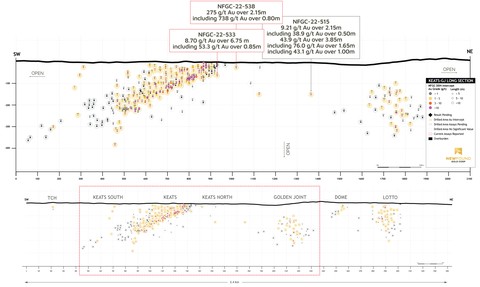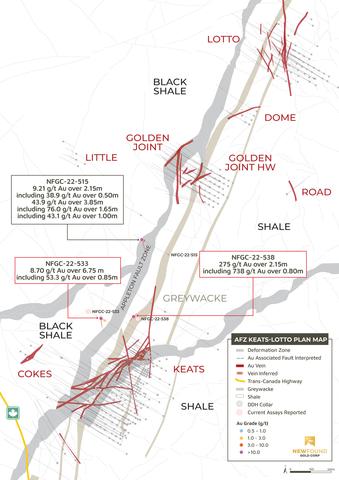
New Found Makes Two New Near Surface Discoveries North of the Keats Zone Intersecting 275 g/t Au Over 2.15m and 8.70 g/t Au Over 6.75m

New Found Gold Corp. (TSX-V: NFG) (NYSE-A: NFGC) is pleased to announce two new high-grade gold near surface discoveries hosted by two separate structures within ~65m of the north end of the Keats Zone. Both holes were drilled as part of a planned systematic program to drill test along the Appleton Fault Zone. New Found’s 100% owned Queensway project comprises an approximately 1500km2 area, accessible via the Trans-Canada Highway approximately 15km west of Gander, Newfoundland.
Keats North Highlights:
| Hole No. | From (m) | To (m) | Interval (m)1 | Au (g/t) | ||||
| NFGC-22-533 | 98.25 | 105.00 | 6.75 | 8.70 | ||||
| Including | 100.65 | 101.50 | 0.85 | 53.3 | ||||
| And | 127.40 | 129.55 | 2.15 | 1.60 | ||||
| NFGC-22-538 | 32.45 | 34.60 | 2.15 | 275 | ||||
| Including | 33.10 | 33.90 | 0.80 | 738 |
Table 1: Keats North Drilling Highlights
1Note that the host structures are interpreted to be steeply dipping and true widths are unknown at this time. Infill veining in secondary structures with multiple orientations crosscutting the primary host structures are commonly observed in drill core which could result in additional uncertainty in true width. Composite intervals reported carry a minimum weighted average of 1 g/t Au diluted over a minimum core length of 2m with a maximum of 2m consecutive dilution. Included high-grade intercepts are reported as any consecutive interval with grades greater than 10 g/t Au. Grades have not been capped in the averaging and intervals are reported as drill thickness.
- The systematic drill program launched in early 2022 to test the ~700m gap between the Keats and Golden Joint zones has now discovered three new and separate structures hosting high-grade gold mineralization: the two new discoveries reported in this release and the 515 Zone discovery of 43.9 g/t Au over 3.85m reported on April 13, 2022 (Figures 2 and 3).
- Drillhole NFGC-21-538, which intercepted 275 g/t Au over 2.15 at a vertical depth of 22m is located 65m north of the Keats Zone and is hosted within a newly discovered structure adjacent to the AFZ (Figures 2, 3 and 4).
- The intercept of 8.70 g/t Au over 6.75m in NFGC-22-533 located at a vertical depth of 65m is an important discovery as it is hosted by a sequence of black shales that occur on the west side of the AFZ. To date, the majority of mineralization found along this 2.7km segment of the AFZ from Keats to Lotto has been hosted by the sedimentary stratigraphy on the east side of the AFZ. This discovery opens a new prospective domain that is largely unexplored. This high-grade gold interval is associated with a broad domain of deformation interpreted in part to be the AFZ and likely another intervening fault zone.
- The high-grade gold mineralization at the three new discoveries is similar to the epizonal character of the Keats, Golden Joint and Lotto zones that occur along this segment of the AFZ (Figure 1).
- Three drills are actively following up on these new discoveries, within the Keats – Golden Joint gap.
Melissa Render, VP Exploration for New Found, stated: “Momentum is building. We have made three new high-grade discoveries over the past two months, all occurring in newly identified structures and located in different stratigraphic positions north of Keats. We are very encouraged by these results and excited to expand on these new high-grade gold discoveries and determine how they fit into the overall structural network of gold bearing faults that is emerging adjacent to the AFZ. The frequency of these new high-grade discoveries is a testament to the strength and scale of the gold system at Queensway. Our growing understanding of this segment of the AFZ is guiding our interpretation and exploration efforts along the 9.5km of strike length at Queensway North and an additional +80km of unexplored strike length at Queensway South which will see an initial drill program commence in the coming months with a focus on the AFZ southern extension.”
Discussion
Mineralization at the Queensway Project is hosted by a fold-thrust sequence of northeast-striking, steeply dipping turbiditic sedimentary rocks deposited and deformed during the closure of the Iapetus Ocean and subsequent continent-continent collision. During this prolonged period of continued shortening, at least two regional-deformation zones developed and include the Appleton and JBP fault zones. The AFZ is interpreted to be a significant, deep-seated thrust fault, that strikes southwest across the full 100km+ length of the property and is likely the main conduit for the gold mineralizing fluids, much like the Cadillac-Larder Lake Fault Zone in the Abitibi.
As a result of progressive deformation, the brittle host stratigraphy developed an extensive network of gold-bearing fault zones enveloping the AFZ, the extents of which are not yet known. This structural relationship demonstrates the currently defined vein and associated fault orientations based on structural interpretation and drilling to date along the 1km corridor from Golden Joint to Lotto. Higher-grades and widths of gold mineralization occur in areas where there was greater mineralizing fluid flow such as at structural intersections, at dilational openings within fault structures, and along lithological contacts where breakage occurs due to rheological differences in the compressional strength of contrasting sedimentary rock units.
The Company’s current interpretation is that the high-grade gold mineralization being drilled at Queensway was deposited by gold mineralizing fluids penetrating this highly fractured and deformed meta-sedimentary sequence forming an extensive mineralized corridor surrounding the deep crustal-scale fault network that forms the Appleton Fault Zone. A significant amount of the high-grade gold mineralization is interpreted to be epizonal in nature, having been emplaced when tectonic movements resulted in the explosive tapping of deep gold-rich magmatic fluids that rapidly precipitated gold as they migrated towards surface.
Drillhole Details
| Hole No. | From (m) | To (m) | Interval (m)1 | Au (g/t) | ||||
| NFGC-22-533 | 98.25 | 105.00 | 6.75 | 8.70 | ||||
| Including | 100.65 | 101.50 | 0.85 | 53.3 | ||||
| And | 127.40 | 129.55 | 2.15 | 1.60 | ||||
| NFGC-22-538 | 32.45 | 34.60 | 2.15 | 275 | ||||
| Including | 33.10 | 33.90 | 0.80 | 738 |
Table 2: Summary of composite results reported in this release for Keats North
1Note that the host structures are interpreted to be steeply dipping and true widths are unknown at this time. Infill veining in secondary structures with multiple orientations crosscutting the primary host structures are commonly observed in drill core which could result in additional uncertainty in true width. Composite intervals reported carry a minimum weighted average of 1 g/t Au diluted over a minimum core length of 2m with a maximum of 2m consecutive dilution. Included high-grade intercepts are reported as any consecutive interval with grades greater than 10 g/t Au. Grades have not been capped in the averaging and intervals are reported as drill thickness.
| Hole No. | Azimuth (°) | Dip (°) | Length (m) | UTM E | UTM N | |||||
| NFGC-22-538 | 300 | -45 | 386 | 658193 | 5427710 | |||||
| NFGC-22-533 | 120 | -45 | 320 | 657951 | 5427748 |
Table 3: Details of drill holes reported in this release
Queensway 400,000m Drill Program Update
Approximately 43% of the planned 400,000m program at Queensway has been drilled to date with ~20,000m of the core with pending assay results. Eleven core rigs are currently operating and New Found is targeting an increase in the drill count to 14 rigs.
Sampling, Sub-sampling, Laboratory and Discussion
True widths of the intercepts reported in this press release have yet to be determined and further exploration is required. Infill veining in secondary structures with multiple orientations crosscutting the primary host structures are commonly observed in drill core which could result in additional variability in true width. Assays are uncut, and composite intervals are calculated using a minimum weighted average of 1 g/t Au diluted over a minimum core length of 2m. All HQ split core assays reported were obtained by either complete or 3.0kg sample metallic screen/fire assay or standard 30-gram fire-assaying with ICP finish at ALS Minerals in Vancouver, British Columbia, ALS is under a commercial contract with New Found. The metallic screen assay method is selected by the geologist when samples contain coarse gold or any samples displaying gold initial fire assay values greater than 1.0 g/t Au. Drill program design, Quality Assurance/Quality Control and interpretation of results is performed by qualified persons employing a Quality Assurance/Quality Control program consistent with industry best practices. Standards and blanks are included with every 20 samples for Quality Assurance/Quality Control purposes by the Company as well as the lab. Approximately 3% of sample pulps are sent to secondary laboratories for check assays. The Company does not recognize any factors of drilling, sampling or recovery that could materially affect the accuracy or reliability of the assay data disclosed.
Qualified Person
The technical content disclosed in this press release was reviewed and approved by Greg Matheson, P. Geo., Chief Operating Officer, and a Qualified Person as defined under National Instrument 43-101. Mr. Matheson consents to the publication of this news release dated May 4, 2022, by New Found. Mr. Matheson certifies that this news release fairly and accurately represents the information for which he is responsible.
About New Found Gold Corp.
New Found holds a 100% interest in the Queensway Project, located 15km west of Gander, Newfoundland, and just 18km from Gander International Airport. The project is intersected by the Trans-Canada Highway and has logging roads crosscutting the project, high voltage electric power lines running through the project area, and easy access to a highly skilled workforce. The Company is currently undertaking a 400,000m drill program at Queensway, now approximately 43% complete. The Company is well funded for this program with cash and marketable securities of approximately $100 million as of May 2022.

Figure 1: Photo of mineralization from NFGC-22-538 at approximately 33.5m down hole depth. Note that these photos are not intended to be representative of gold mineralization in hole NFGC-22-538 (Photo: Business Wire)

Figure 2. Keats to Golden Joint long-section (Graphic: Business Wire)

Figure 3. Keats – Lotto plan view map (Graphic: Business Wire)
MORE or "UNCATEGORIZED"
Kuya Silver Confirms High-Grade Silver-Gold Vein Mineralization at Umm-Hadid with Initial Drill Results up to 1483.9 g/t AgEq over 2 Metres
Kuya Silver Corporation (CSE: KUYA) (OTCQB: KUYAF) (FSE: 6MR1) is... READ MORE
First Phosphate Closes Final Tranche of Oversubscribed Private Placement
First Phosphate Corp. (CSE: PHOS) (OTCQX: FRSPF) (FSE: KD0) is... READ MORE
GFG Receives Final Payment from the Sale of its Rattlesnake Hills Gold Project
GFG Resources Inc. (TSX-V: GFG) (OTCQB: GFGSF) announces that i... READ MORE
Goliath Receives $1,730,882 Through Warrant Exercises, Inclusive Of Crescat Capital A Longtime Strategic And Cornerstone Shareholder
Goliath Resources Limited (TSX-V: GOT) (OTCQB: GOTRF) (FSE: B4IF)... READ MORE
Robex Pours First Gold at Kiniéro on Schedule and Budget
Highlights: Gold bar weighing 2.64 kilograms (85 oz) poured in th... READ MORE












